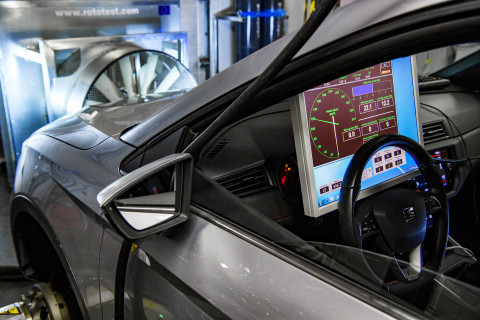Earlier this year, a comprehensive measurement campaign was conducted in the ILMARI laboratory on the Kuopio Campus to study particulate matter and ultrafine particle emissions from modern cars. This time, the focus was on new passenger vehicles running on diesel, gasoline and natural gas.
ULTRHAS (ULtrafine particles from TRansportation - Health Assessment of Sources) is an international research project that examines particulate matter emissions from vehicles as well as their environmental health risks. Emissions from transportation should be considered in, e.g., urban planning, as they are harmful to human health.
Professor Pasi Jalava at the Department of Environmental and Biological Sciences, and Professor Olli Sippula at the Department of Chemistry and the Department of Environmental and Biological Sciences, together with their research groups, have conducted emission measurements in several projects. In the now-concluded campaign, emissions were measured from new cars running on diesel, gasoline and natural gas.
“The project has previously conducted measurement campaigns in Germany, where particulate matter emissions were measured from various sources, including ship and aircraft engines,” Jalava says.
Driving has an adverse effect on air quality due to direct particulate emissions from exhaust gases. This is why recent years have seen significant steps in European legislation to restrict particulate matter emissions from cars.

When it comes to new vehicles, most particulate matter seems to be formed from the gases contained in their emissions, which through atmospheric reactions create so-called secondary particulate matter. Particulate matter emissions also arise from tire wear, as well as from the wear of brake surfaces during braking.
“In this measurement campaign, we focused on the amount of secondary particulate matter that can be formed in the atmosphere from the exhaust emissions of new passenger cars. We also want to find out how the health-relevant properties of secondary particulate matter differ from those of primary emissions,” Sippula notes.
“From a toxicological perspective, it is important to understand which harmful components are contained in emissions,” Jalava says.
The month-long measurement campaign involved nearly 40 researchers from Finland, Germany, Norway and Switzerland.
“Collaboration with researchers from different fields was smooth, but it also required precise coordination of the measurements, as well as good communication,” Postdoctoral Researcher Anni Hartikainen says.

Particulate matter can cause inflammation
The measurement campaign provided a wealth of data for research into human health. An important part of the experiment was measuring the physiological effects of emissions using cell exposure devices. Exhaust gas was directed onto small sample plates containing human lung cells. The conditions of the experiments, such as humidity and temperature, could be regulated accurately, mimicking the conditions of the airways.
For the experiments, respiratory tract cells and immune defence cells were grown on a semi-permeable membrane in air-liquid interface, where the cells are exposed directly from the air.
“This cell model acts as a barrier to particulate matter, similar to the human lung epithelium,” Researcher Johannes Becker of Helmholtz Zentrum München notes.
However, when fine particles damage cells, they can penetrate the barrier and enter the bloodstream, and from there into other parts of the body as well, causing inflammation and other detrimental effects. The experiment investigated the exposure of the lung cells, and mouse lungs, to various conditions to reveal the potential mechanisms of adverse health effects.

We want to find out which particles and particulate components are especially harmful, and how the aging of emissions in the atmosphere affects their toxicity.
Johannes Becker
Researcher
However, when fine particles damage cells, they can penetrate the barrier and enter the bloodstream, and from there into other parts of the body as well, causing inflammation and other detrimental effects. The experiment investigated the exposure of the lung cells, and mouse lungs, to various conditions to reveal the potential mechanisms of adverse health effects.
The aim is to link the toxicological mechanisms to effects in the entire human body.
“Pathogenic mechanisms can vary in intensity in different people and in different sexes,” Jalava points out.
“Next, we’ll be doing toxicological analyses of the tissue samples in the laboratory. The project’s results will be published next year.”
- More information on the project is available on the Horizon2020 Cordis page
- ULTRHAS project website
- ILMARI laboratory website





